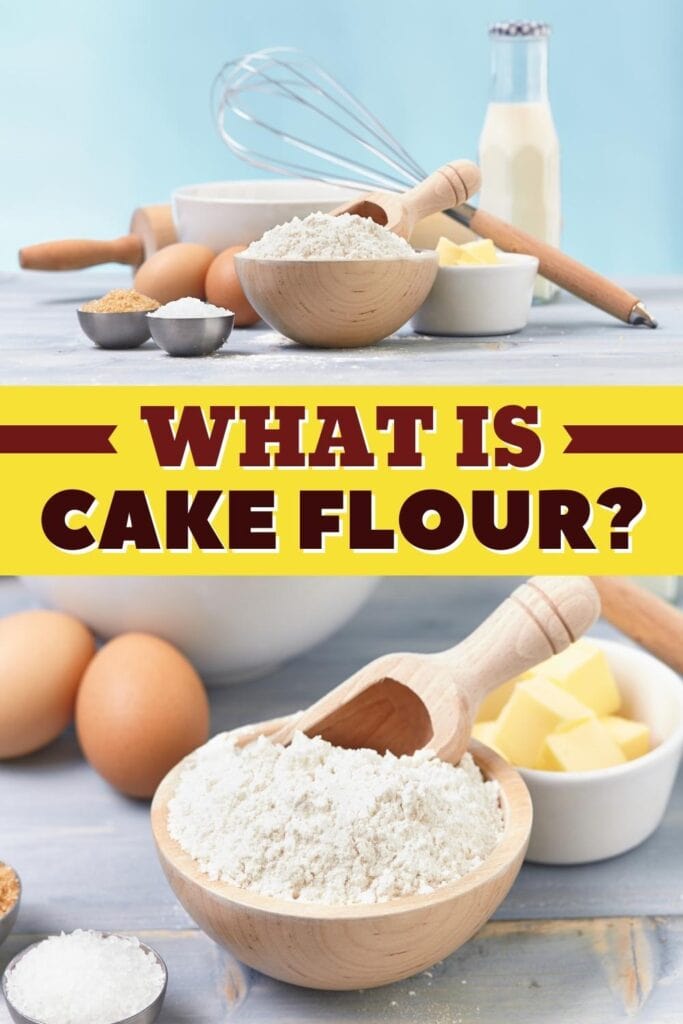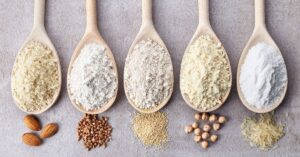Calling all bakers and cake connoisseurs! Have you ever found yourself wondering, “What is cake flour?”
Is it just flour meant for cakes? Let’s find out!

You know that feeling when you bite into a cake, and it’s so light and fluffy it practically melts in your mouth?
That’s cake flour at work.
From pancakes to heavenly red velvet cake, cake flour works its undercover magic.
It can turn these treats into irresistible cloud-like confections.
Whether you’re a seasoned baker or just starting out, cake flour is a serious game-changer.
Go ahead and grab yourself a bag and get ready to bake the fluffiest, softest cakes of your dreams.
What Is Cake Flour?
Cake flour is a type of finely milled flour with a lower protein content than all-purpose flour.
This means it produces less gluten, which results in a lighter, fluffier cake.
And who doesn’t want that?
What’s the Difference Between Cake Flour and All-Purpose Flour?
All-purpose flour has more protein in it, around 10-12%. That means it makes more gluten, which gives you a denser texture.
Cake flour, on the other hand, has less protein, about 7-9%. That’s why, if you’re looking for a super light, fluffy cake, you gotta go with cake flour.
Just to give you a sense of things, bread flour has even more protein, which is great for making chewy bread with a good bite to it.
The goal with cake is to keep it light and fluffy, so we don’t want too much gluten.
That’s why cake flour is perfect for the job!
Now, not all cake recipes call for cake flour, but when they do, you want to pay attention.
It’s the key to creating that dreamy texture we all crave.

What Does Cake Flour Do For Baking
First off, cake flour’s lower protein content helps prevent the formation of an overly-elastic gluten network.
You know, that pesky little thing that can make your cakes feel like a workout for your jaw?
Yeah, no more of that! Instead, you get tender, fluffy cakes that just melt in your mouth.
Second, cake flour’s finer texture works wonders in enhancing the overall consistency of your batter.
It’s super-fine and silky, which allows it to blend seamlessly with other ingredients for an even, velvety crumb.
But hey, not every recipe can handle the delicacy of cake flour.
Take chocolate cake, for example. It’s got cocoa powder, which is already super fine.
Mix that with cake flour, and you might end up with a wobbly cake.
The same goes for carrot cake and banana cake.
They have extra wet ingredients from fruits or veggies, so cake flour isn’t the best choice.
You want a tougher flour, like all-purpose flour, for those.
When do I bust out the cake flour?
I love it for vanilla cake, red velvet cake, and any other cake that deserves a fluffy, cloud-like texture.

Cake Flour vs. All-Purpose Flour (What’s the Difference?)
Here’s what sets cake flour and all-purpose flour apart:
- Protein: As I’ve mentioned before, cake flour packs a lower protein punch compared to all-purpose flour (around 8% versus 10-12%).
Less protein means less gluten formation, which means lighter, more tender bakes.
- Fineness: Cake flour is finely milled. It’s silky and smooth, making it easier to blend with other ingredients for that perfect, even crumb.
All-purpose flour, on the other hand, has a coarser texture.
- Versatility: As the name suggests, all-purpose flour is great for, well, all purposes! From cookies and bread to pies and pastries, all-purpose flour has got your back.
Cake flour, while a rockstar for delicate bakes, isn’t always the best choice for recipes that require more structure or chewiness.
- Color: If you’ve ever noticed a subtle difference in color between cake and all-purpose flour, you’re not seeing things!
Cake flour is slightly paler due to the bleaching process it undergoes.
This not only affects the color but also alters the flour’s pH level, making it more acidic.
As a result, it helps tenderize the gluten even more, giving cake flour that extra edge in creating tender bakes.

How to Make a Homemade Cake Flour Substitute
What you’ll need:
- All-purpose flour
- Cornstarch
- A sifter or fine mesh strainer
Here’s the simple 3-step process to transform your all-purpose flour into a cake flour dupe:
Step 1: For every cup of cake flour needed in your recipe, measure out 1 cup of all-purpose flour. Then, remove 2 tablespoons of the flour from that cup.
Step 2: Replace the 2 tablespoons of all-purpose flour you just removed with 2 tablespoons of cornstarch. This magical ingredient helps lower the protein content, mimicking the properties of cake flour.
Step 3: Grab your sifter or fine mesh strainer and sift the all-purpose flour and cornstarch mixture together at least twice. This step is crucial for achieving that light and airy texture in your bakes.
Can I Use All-Purpose Flour as a Substitute For Cake Flour?
The short answer is yes, with a little twist!
Cake flour indeed has that tenderizing touch thanks to its lower protein content.
But you can still work some kitchen magic to make all-purpose flour a viable stand-in.
In the substitute section above, there’s an easy 3-step process to create your own cake flour dupe.
You just need all-purpose flour and cornstarch.
And remember: measure up, add cornstarch, and sift away!










